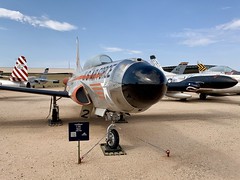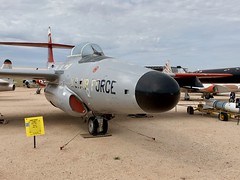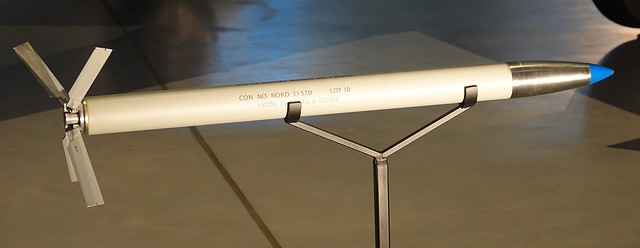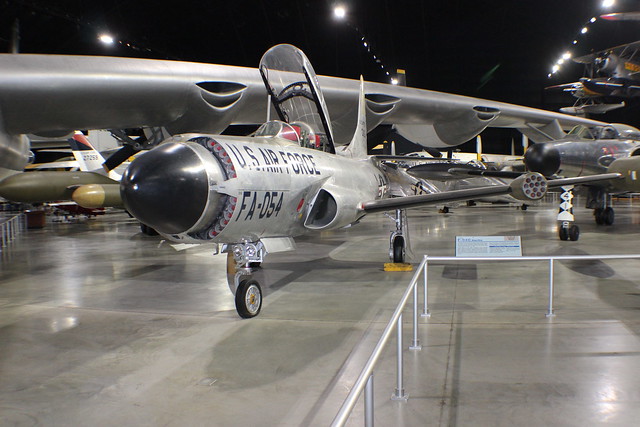This post has been on the back burner for a while. I really should stop jumping around and take a more chronological approach to the aircraft I write about on Paul’s Thing, but then again if I tried to do that I’d never know where to start or when to end.
I grew up as an Air Force brat in the 1950s and 60s, and one trend or theme you may have noticed with my Air-Minded posts is an abiding interest in the jets of that era, plastic models of which hung from the ceilings of my base housing bedrooms in the USA and Germany (just not, as noted, in any particular order). Anyway, I finally got off my butt with this post, and here it is.
Three early-1950s jet interceptors sit side-by-side on USAF fighter row at Pima Air and Space Museum: an F-86L Sabre, an F-94C Starfire, and an F-89J Scorpion. Not one of these jets made it onto the list of exhibits we tram docents are supposed to tell visitors about, but I occasionally deviate from the script.
Condemn me if you will, but I never cared for the dog-nosed version of the Sabre, and since I already tell visitors about a beautiful air-to-air F-86H Sabre displayed nearby, I ignore its fugly sister. When I go off-script with the early jet interceptors, I concentrate on the straight-wing jets, the Starfire and the Scorpion, the subjects of this post.
I’ve written elsewhere about USAF interceptor pilots and their tools: their aircraft, the ground-based radar infrastructure developed to guide them to their targets, the weapons they employed. In this post, I want to take a more narrow look at the Starfire and Scorpion, and the air-to-air weapon most commonly associated with both.
 |
 |
 |
The air threat to the USA, as seen in the late 1940s and early 1950s, was an attack by Soviet bombers. Never mind that Russian bombers of the day didn’t have the range to reach North America, our military planners assumed the worst and thought ahead. And so we began developing jet interceptor aircraft and weapons to shoot those bombers down.
The F-94 was our first dedicated jet interceptor, the result of a 1948 USAF requirement for a radar-equipped interceptor to counter the threat of the USSR’s Tupolev Tu-4, a reverse-engineered B-29 bomber. The F-94 was based on the existing Lockheed T-33 Shooting Star trainer, with an added radar and afterburner-equipped engine, and was introduced to the USAF in mid-1950. It carried a crew of two: a pilot in the front seat and a radar operator in the back. Never intended to be more than an interim interceptor, based on available technology and capabilities, the USAF from the beginning planned to replace it with more capable aircraft and weapons when such became available. F-94s were largely phased out by 1955 (some continued serving in active USAF squadrons until 1958, and the Air National Guard didn’t get rid of them until 1959).
Curiously enough, the first two versions of the F-89, the A and B models, were armed solely with four nose-mounted .50 caliber machine guns. We already knew, from experience in WWII, that .50 caliber rounds were inadequate against bomber-sized targets, and early feedback from Korea indicated that .50 caliber wasn’t all that great against small MiG-15 fighters either. So a lot of effort went into making a better version of the F-94, the C-model Starfire introduced in July 1951. This was the most-produced version of the aircraft, the one you’re most likely to see on display at air museums today. The C model was the first to use the name Starfire, which in time became the name applied to earlier models as well. It had an upgraded radar and fire control system, a more powerful engine, and, most significantly, all-new weaponry: the machine guns were ditched in favor of nose-mounted folding fin aerial rockets, the Mark 4 “Mighty Mouse.”

The first F-94C Starfires carried two dozen Mighty Mouse rockets, six each behind four inward-opening trap doors in the nose. Two wing pods carrying a dozen rockets each were soon added, with fiberglass nose cones that were simply blasted away when the rockets were launched. Here’s a photo I took last year at the USAF Museum, showing an F-94C Starfire armed with its full load of 48 Mighty Mouse rockets:

As noted at the beginning of this post, I’m pretty much ignoring the interceptor version of the North American F-86, the F-86D model (most later converted to slightly improved F-86Ls like the one on display at my museum), which was armed with two dozen Mighty Mouse FFARs in a retractable “tray” mounted on the belly. Instead, I’ll skip to Northrop’s F-89 Scorpion.
The Scorpion derived from same 1948 USAF requirement responsible for the F-94 Starfire. Like the Starfire, the Scorpion was a two-seater with a pilot and radar operator. Although the first F-89s began flying for the USAF only a few months after the introduction of the F-94, later models of the Scorpion, introduced in the mid-1950s, were far more capable interceptors and eventually replaced the Starfires. The Scorpion was a USAF mainstay for almost 20 years, with the last ones retiring from the Air National Guard in 1969.
Early F-89 Scorpions were armed with six nose-mounted 20mm cannon, a potent weapon against bomber-size targets. As with the Starfire before it, however, later models of the Scorpion swapped the guns for Mighty Mouse FFARs. The F-89D, the most-produced model of the Scorpion, was armed with 104 FFARs, 52 each in wingtip-mounted combination fuel & rocket pods. For several years the Mighty Mouse rocket was the Scorpion’s only weapon (later, when the first generation of semi-active radar and infrared-homing guided missiles became available, the Scorpion was the first interceptor to carry them, but that’s another subject for another day).

Which brings us back to the Mighty Mouse, a weapon that to date has not shot down a single bomber, at least to my knowledge, or anything else. The Germans had some success using aerial rockets against Allied bombers in WWII, and in the days before radar-guided and heat-seeking missile technology, aerial rockets seemed a good bet against Soviet bombers. They carried powerful warheads, had a max range of over 3,000 yards, and were spin-stabilized in flight to give them a straight trajectory. But they weren’t guided, were notoriously inaccurate, and the one time we used them against an actual airborne threat, Mighty Mouse failed to save the day.
That sad occasion, of course, was the famous Battle of Palmdale. It’s a story most of you have heard. If you want the gory details you can follow the link, but here’s the short version:
The US Navy had converted some old Grumman F6F Hellcat prop fighters to use as remotely-piloted targets in its air-to-air missile development program. On 16 August 1956 they launched one from Point Mugu toward a test area over the Pacific, but shortly after takeoff it stopped responding to ground commands. Flying autonomously, the runaway Hellcat turned back toward land. Fearing it would crash in a populated area … downtown Los Angeles, for example … the USAF launched two alert F-89D Scorpions from Oxnard AFB. Their mission: intercept the Hellcat and shoot it down over an unpopulated area.
The first jet interceptors had small, short-range radars, useful only during the terminal portions of an intercept. Interceptors were vectored toward their targets by ground-based radar, a network of which over time grew into an integrated North American air defense structure familiar to anyone with memories of the Cold War: NORAD, SAGE, the Pine Tree Line, the DEW Line, and Cheyenne Mountain … possible subjects for future Air-Minded posts. But back to our intrepid Scorpion aviators, who by now had been vectored by ground-based radar controllers toward the runaway drone, finally sighting it and preparing to shoot it down.
The Hellcat by this time was flying large circles in the vicinity of Santa Paula, California. As it turned toward an unpopulated desert area, the Oxnard aircrews armed up and closed to firing range. Their F-89Ds had a new Hughes-developed fire control system that was supposed to automatically bring the Scorpion in on a 90-degree angle to the target (considered best against bombers since it wouldn’t expose you to tail gun fire), calculate the correct lead and elevation, aim the aircraft (and thus the rockets), and auto-launch at the ideal range. And while the Scorpions’ fire control systems may have done everything else correctly, the auto-launch did not occur and the aircrews had to reposition their jets for a second attack and manual rocket launch.
When they put in the fancy Hughes fire control system, they took out the old cockpit gunsight. The automatic system was supposed to position and aim the F-89 correctly to ensure the rockets would shoot at the proper lead angle and fly straight to the target. The Scorpion pilots now had to launch visually, without gunsights, taking what F-15 pilots in my day would call a WAG (wild-ass guess) at lead and elevation angles, as well as a TLAR (that looks about right) at the correct range. Which you have to admire, and they did their best. The two F-89 aircrews launched their combined 208 Mighty Mouse rockets at the Hellcat, and while even a single rocket hit would have been enough to bring it down, not a single one did hit it (although in debrief the aircrews said they saw a few glance off the bottom of the Hellcat without detonating).
What happened to the errant rockets? Mighty Mouse warheads armed on launch and were supposed to disarm as the rockets’ speed decreased. Many didn’t disarm, however, and detonated when they hit the ground, starting a brush fire near the town of Castaic. Others landed in Newhall and Palmdale, damaging houses and automobiles. Yet others started additional brush fires near those towns, and a few set oil tanks on fire at a drilling site.
As the Scorpions flew home in defeat, the Hellcat ran out of gas and spiraled down toward Palmdale. It missed the town and crashed near Palmdale Regional Airport, severing power lines in its last seconds of flight, fortunately injuring no one on the ground.
Would the Air Force like to forget the Battle of Palmdale? Sure it would. Are today’s aircraft and weapons better equipped to bring down enemy air threats? Absolutely … but still far from perfect (another topic for a future post).
Are FFARs still around? You bet they are. Turns out they’re great weapons to use against stationary and slow-moving ground targets, and today they’re carried on Army and Marine attack helicopters.
Tell you what, I have mountains of respect for the men who flew these early jet interceptors and had to make do with the technological limits of their day. They paved the way for me and my squadron mates, our F-15 Eagles, and the AIM-7 Sparrow and AIM-9 Sidewinder missiles we carried against what was still, in our day—the 1970s, 80s, and 90s—a massive Soviet air threat. I do my best to communicate to Pima Air and Space Museum visitors the odds my forebears faced and the esteem in which I hold them, and hope they carry some of that home with them.
I thought you might enjoy watching these two black & white USAF videos I found on YouTube. The first shows weapons crews loading FFARs, a Starfire being launched and vectored toward its target by ground radar controllers, and the launch of its Mighty Mouse rockets at the target. Toward the end you can even see the rockets blasting through the wing pod’s nose cone. The second video shows Mighty Mouse rockets being launched from F-89 Scorpions, and includes a great slow-motion segment of rockets emerging from a wingtip pod, unfolding their fins and beginning to spin, and shooting off (not always straight) toward the target. I think the video even shows those rockets hitting their target, but the film is faded and it’s hard to tell. Anyway, great fun.
Here are some reference links if you’d like to know more:

Hi Paul,
Thanks for writing the above. I’m documenting my father-in-law’s time in the F-94 and F-89s. I understand he was the in first group of pilots and radar operators and experienced the F-94A and F89C so he didn’t have experience with the rockets. But I’m curious as to the type of fuse the Air Force used on the Mighty Mouse FFARs — point or proximity. From the perspective of your blog I presume they must have used point fuses. Can you confirm please?
Thanks again!
John, there’s a good discussion here: https://en.wikipedia.org/wiki/Folding-Fin_Aerial_Rocket#Fuzing_Options
Based on what I know, it looks like the F-94 & F-89 used the Mk IV version of the FFAR, which would have had the point detonation fuze. Proximity fuzes came later and that’s what they probably use today … yes, FFARs are still in use, mostly on attack helos.